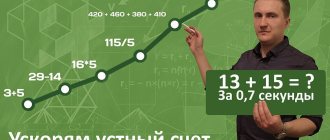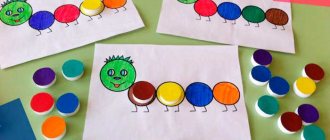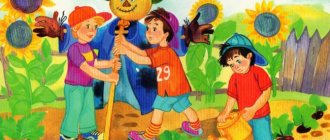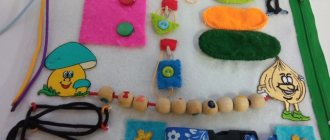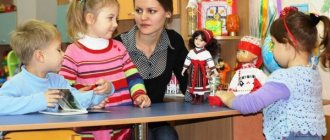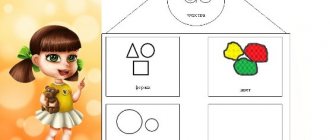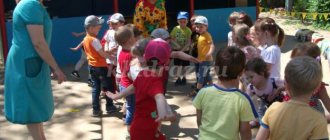Question 1. Teaching children quantitative calculations in kindergarten
1. Theoretical questions:
The purpose of teaching numeracy. Techniques for teaching quantitative counting. Children's mistakes when counting. The role of auditory and speech analyzers at the first stage of training. The difference between teaching quantitative calculation to older preschoolers and younger ones. Techniques for teaching the independence of numbers from magnitude, distance, location in space, direction of counting. Consolidating knowledge about quantitative calculation in everyday activities.
2.Practical task:
Give an example of a game technique for the following program task: introduce children to the number 3, teach children to count to 3.
3. Basic concepts:
counting, quantitative counting, teaching techniques.
4.Primary researchers
: A.M. Leushina, N.A. Menchinskaya, L.F. Obukhova, V.V. Danilova, N.I. Chuprikova, Z.S. Pigulevskaya.
Theoretical questions.
Working with sets, comparing them by mutually comparing the elements of one set with the elements of another creates the basis for the transition to teaching counting activities.
Check
- this is the establishment of a one-to-one correspondence between the elements of a set and a segment of the natural series (numbers - an abstract mathematical concept).
Accounting activities –
naming numerals in order and correlating them to each element of the set, highlighting the final number.
The purpose of teaching numeracy
consists not only of learning the ability to name numerals in order, answer the question “how much?”, while naming the total of the count, but also becoming familiar with the formation of each subsequent and previous number based on adding an object to one of the sets being compared.
Techniques for teaching quantitative counting.
Teaching counting to children of middle preschool age is carried out within 5 and is necessarily based on the comparison of two groups of objects located parallel in two rows below each other. The groups being compared must differ in only one element, i.e. reflect successive numbers: 1 and 2, 2 and 3, 3 and 4, 4 and 5. This creates a visual basis for mastering the principle of formation of each subsequent (previous) number in the natural series, helps to understand why one group of objects is called one number, and another – to others. We teach children methods of counting objects according to a model (“do as I do”), first we practice following the rules, and after mastering them, canceling external gestures. The work is carried out using a wide variety of visual material.
The teacher repeatedly shows and explains the rules of counting
:
- name the numbers in order, starting with the word “one”,
- touch each object with your leading hand from left to right,
- assign only one number to one object,
- at the end, make a generalizing gesture and once again name the last number (“only five items”).
These rules are necessary so that children understand the essence of counting, and the teacher can prevent or identify errors (in counting, not in the rules).
When learning to count, children may experience the following errors:
:
- name the numerals out of order, starting with the word “one”;
- miss objects, touch one object twice;
- count their movements, not objects, there is no coordination between word and movement;
- do not single out the final number (“no-total count”), cannot answer the question “how much?”;
- find it difficult to coordinate numerals with nouns;
- name an object after each numeral;
- confuse cardinal and ordinal numbers.
When children learn to count objects, you can teach them how to count objects.
Goal: to teach how to count the required number of objects from a larger one.
1. Counting according to a pattern: children are asked to count the objects on the pattern and remember their number, then count the same number of objects.
2. Counting according to the named number: “Set aside five circles and one more. How much did you get? (familiarity with the formation of neighboring numbers).
Counting using various analyzers
. Along with counting objects with the participation of the visual analyzer, children need to practice counting by ear, by touch, and also in counting movements. For example, the teacher asks the children to count how many times he hits a tambourine, drum, table, etc., how many steps he takes, or asks them to perform as many movements as there are objects drawn on the card, clap their hands as many times as the hammer hits . Then you should teach children to make movements according to the named number: “Sit down four times,” “Throw the ball up three times,” etc.
In older preschool age, simultaneously with the formation of numbers within 10, it is necessary to show the independence of numbers from various characteristics of objects: size, distance, location in space, direction of counting.
To show the independence of the number from the size of the objects, 2 groups of balls are taken, equal in number (5 each), but different in size (large and small). Items do not have to be placed in a row. The teacher asks: “Is the number of balls the same?” Most often, children think that there are more big balls. It is proposed to compare them by application - one to one, or by recalculation, or better yet, both. Then you should ask questions: “Why did many people think that there are more big balls than small ones? Can there be equal numbers of large and small objects? Has the number of objects changed because they are different sizes? In what case will the number of objects change? Then, by adding (subtracting) an object to a set, you need to show the formation of the next (previous) number. Questions: “How many balls are there?”, “How did you get 6 balls? How is the number 6 formed? Which balls are there more? Which number is greater than 5 or 6? We bring the children to the conclusion that objects can be taken large or small and still receive the same quantity.
To show the independence of number from the distance between objects, identical groups of objects are taken, equal in number, but in one group the objects are placed at a large distance from each other, and in the other group - nearby. The questions are similar, but attention is paid to the distance between objects.
To show the independence of number from the arrangement of objects in space, 2 groups of identical objects are taken, equal in number, but located differently (the questions are similar), the difference is as follows - we lead children to the conclusion that the same number of objects can be arranged in different ways , the number will not change.
To introduce children to the independence of numbers from the direction of counting, it is necessary to invite children to count objects from left to right and vice versa. It is important to remember the number. You can put a number at the end of each recount. The teacher asks: “Has the number changed because objects are counted in different directions?” We bring children to the conclusion that objects can be counted in any direction - the number will not change.
It is most difficult for children to count objects located in a circle. It is best for this purpose to take objects that differ in some way. The teacher offers to choose an object from which they will start counting. We ask: in which direction is it better to count – clockwise or counterclockwise? Let us conclude that you can count in any direction, because the number does not change.
Counting the same objects in different ways convinces children that it is necessary to remember well the object from which the counting began and lead it in any direction, but at the same time they must not miss a single object and not count a single one twice.
To strengthen counting skills
The teacher constantly uses a large number of games and exercises (for example, “Find a pair”, “Find your house”, etc.). In games with dolls, for example, children find out whether there is enough dishes to receive guests, clothes to collect dolls for a walk, etc. In the game of “shop,” they use check cards on which a certain number of objects or circles are drawn. In everyday life, situations often arise that require counting: on the instructions of the teacher, children find out whether certain benefits or things are enough for children sitting at the same table (boxes with pencils, coasters, plates, etc.). Children count the toys they took for a walk.
Practical task: Give an example of a game technique for the following program task: introduce children to the number 3, teach children to count to 3.
The teacher places two Christmas trees on the bottom strip.
- How many Christmas trees? (count in unison to two)
- Squirrels jumped up on every Christmas tree. Take as many squirrels as Christmas trees.
One of the children puts two squirrels on the top strip exactly above the Christmas tree and counts out loud.
— What can you tell us about Christmas trees and squirrels? (There are as many squirrels as there are Christmas trees; there are as many Christmas trees as there are clowns; 2 each).
After this, the teacher places another squirrel on the top strip (demonstrates the formation of the next number).
— Another squirrel galloped up. Are there more squirrels or fewer? (more).
- There are two Christmas trees, but how many squirrels? We need to count.
The teacher shows a sample counting: “One, two, three - only 3 squirrels.” Using intonation, the teacher highlights the total of the count and circles the images of squirrels with a circular gesture. Offers to repeat how many squirrels there are.
— How did you get 3 squirrels? (there were 2, another one jumped up, i.e. 1 was added to 2.)
— What are more (less) – Christmas trees or squirrels? Why? (more squirrels, one squirrel did not have enough Christmas tree).
— What is more (less) – 2 or 3?
- How to make it equally? (remove one squirrel or add one Christmas tree).
The teacher adds another Christmas tree.
- How many Christmas trees are there? (invites the children to count).
— Are there equal numbers of squirrels and Christmas trees? How many squirrels and Christmas trees are there? How did you get 3 Christmas trees?
Then you need to show the formation of the previous number. To do this, 1 item is removed from any set. The questions are similar.
Psychological and pedagogical foundations of the development of children of middle preschool age
Middle age is the most important period in the development of a preschooler.
The physical capabilities of children have increased: their movements have become much more confident and varied. In the middle group, it is especially important to establish a reasonable motor mode. The middle preschooler needs meaningful contacts with peers. Children communicate about toys, joint games, and common affairs. Their verbal contacts become longer and more active. Children easily unite into small subgroups based on common interests and mutual liking.
The main activity of middle-aged children is play, and productive activities also appear: drawing, modeling, designing. In story games, children easily use various substitute objects (for example, a cube as soap). This develops the child's fantasy and imagination.
In play, the child discovers for the first time the relationships that exist between people; the child himself can fulfill one or another role. The child’s mental activity develops in play. Within the play activity, educational activity also begins to take shape, which later becomes the leading activity. A preschooler begins to learn by playing - he treats learning as a kind of role-playing game with certain rules.
In the middle group, preference is given to the play structure of the entire lifestyle of children. Children participate in a variety of games throughout the day.
All types of classes either take the form of a game or contain game situations and actions. New features appear in the communication of middle preschoolers with the teacher. Children strive for cognitive, intellectual communication with adults. This is manifested in numerous questions from children to the teacher: “Why?”, “Why?”, “For what?”.
Children’s ability to establish the simplest connections and relationships between objects awakens interest in the world around them. The teacher’s friendly, interested attitude towards children’s questions and problems, the willingness to discuss them “as equals” with children helps, on the one hand, to support and direct children’s cognitive activity in the right direction, on the other hand, it strengthens the trust of preschoolers in adults. This promotes a sense of respect for elders.
A preschooler in his fifth year of life is highly active. This creates new opportunities for the development of independence in all areas of his life. There is an awakening of interest in the rules of behavior. The main thing is to anticipate the actions of children and orient them in advance to the correct behavior.
Middle-aged children are highly emotional and express their feelings clearly and directly. The teacher awakens the emotional responsiveness of children, directs it towards sympathy with peers and basic mutual assistance.
Children's aesthetic senses develop. They notice the beauty of nature, the sound of music. An adult helps the child with this. An attentive, caring attitude towards children, the ability to support their cognitive activity and develop independence, and the organization of various activities form the basis for the proper upbringing and full development of children in the middle group of kindergarten.
The teacher gradually develops the gaming experience of each child, helps to discover new opportunities for playful reflection of the world, awakens interest in creative manifestations in play and playful communication with peers.
A preschool child does not have sufficient abilities to connect temporal, spatial and causal sequences with each other and include them in a broader system of relationships. He reflects reality at the level of ideas, and these connections are acquired by him as a result of direct perception of things and activities with them.
When classifying, objects or phenomena are combined based on common characteristics into a class or group, for example: all people who know how to drive a car, etc. Classification forces children to think about the underlying similarities and differences between different things as they need to make inferences about them.
